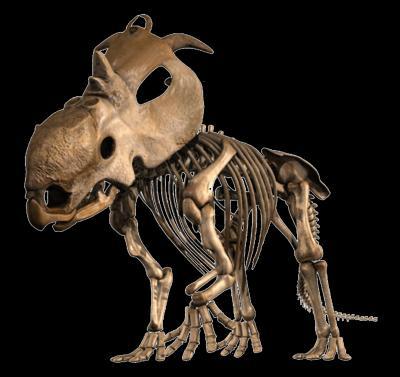The newly unearthed fossil reveals a group of dinosaurs killed in the disaster that happened 72.5 million years ago. They feature a frill behind the skull and small horns. They also have bone-like structures on the nose and eyes. These characteristics have given them the name Pachyrhinosaurus, also known as the thick nose lizard. These structures probably play a role in supporting the keratin horn.
According to Dr. Philip Currie, paleontologist and chairman of Canadian dinosaur paleontology at the University of Alberta, northwest Alberta was previously thought to have no traces of dinosaurs. Until the 1970s when Al Lakusta's excavation and research conducted in the new area made the Tyrrell Museum Hoang Gia embark on excavation of bone-containing seams. Philip Currie also participated in the excavation of new dinosaurs. The name of the lakustai Pachyrhinosaur is to honor Lakusta, currently a retired science teacher.
'The density of Pipestone Creek bone reservoir is very large, far superior to other bone reservoirs in Alberta. The work of keeping and collecting materials also becomes easier. The number of bones of all ages helps the investigation process to learn about behavior and development patterns more conveniently. '
The bone contains the fossils of both the dinosaurs and the old ones, allowing researchers to describe the differences and patterns of development of each animal; From there, learn the possibility of forming bisexual phenomena while at the same time making a hypothesis about the herd lifestyle.
 3D photo illustrating the skeleton of the lakustai Pachyrhinosaur dinosaur. (Photo: Pipestone Creek Dinosaur Project)
3D photo illustrating the skeleton of the lakustai Pachyrhinosaur dinosaur. (Photo: Pipestone Creek Dinosaur Project)
According to Currie, researchers have gained more information to help us better understand the ancient and ecosystem of northwest Alberta at 73 million years ago. Currie, along with Wann Langston and Darren H. Tanke, published a monograph titled "A New Horned Dinosaur from an Upper Cretaceous Bone Bed in Alberta" in the NRC Press (titled "New dinosaurs with horns"). discovered in the upper strata of Alberta Cretaceous bones')
According to Jack O'Toole, Pipestone Creek dinosaur project president, Currie's research and monograph has made the region of Alberta the center of the scientific community.
He explained: 'The collaboration between Grande Prairie School, Royal Tyrrell Museum and University of Alberta has helped discover more places and fossils in the area where we live. Thanks to the research, we now have a deeper understanding of regional ecology. The Northwest Alberta community is also very excited when it owns a unique source of research like this. '
The Pipestone Creek dinosaur project is currently developing three northern sources, within the network of general regional paleontological sites, into a world-class research, education and tourism center to bring about benefits for local communities, for the region and for the whole of Canada. Andrew Neuman, executive director of the Royal Tyrrell Paleontological Museum, explained the importance of the area: 'Excavations at Pipestone Creek give us a lot of great rewards. Research at a previously unknown site but numerous countless traces of the long frame has shown that Alberta is rich with useful resources for paleontology. '
 Discovered an ancient centipede fossil 99 million years old
Discovered an ancient centipede fossil 99 million years old Discovered bat-like dinosaurs in China
Discovered bat-like dinosaurs in China Discovered a 200-year-old bronze cannon of the coast
Discovered a 200-year-old bronze cannon of the coast Discover 305 million-year-old spider fossils
Discover 305 million-year-old spider fossils